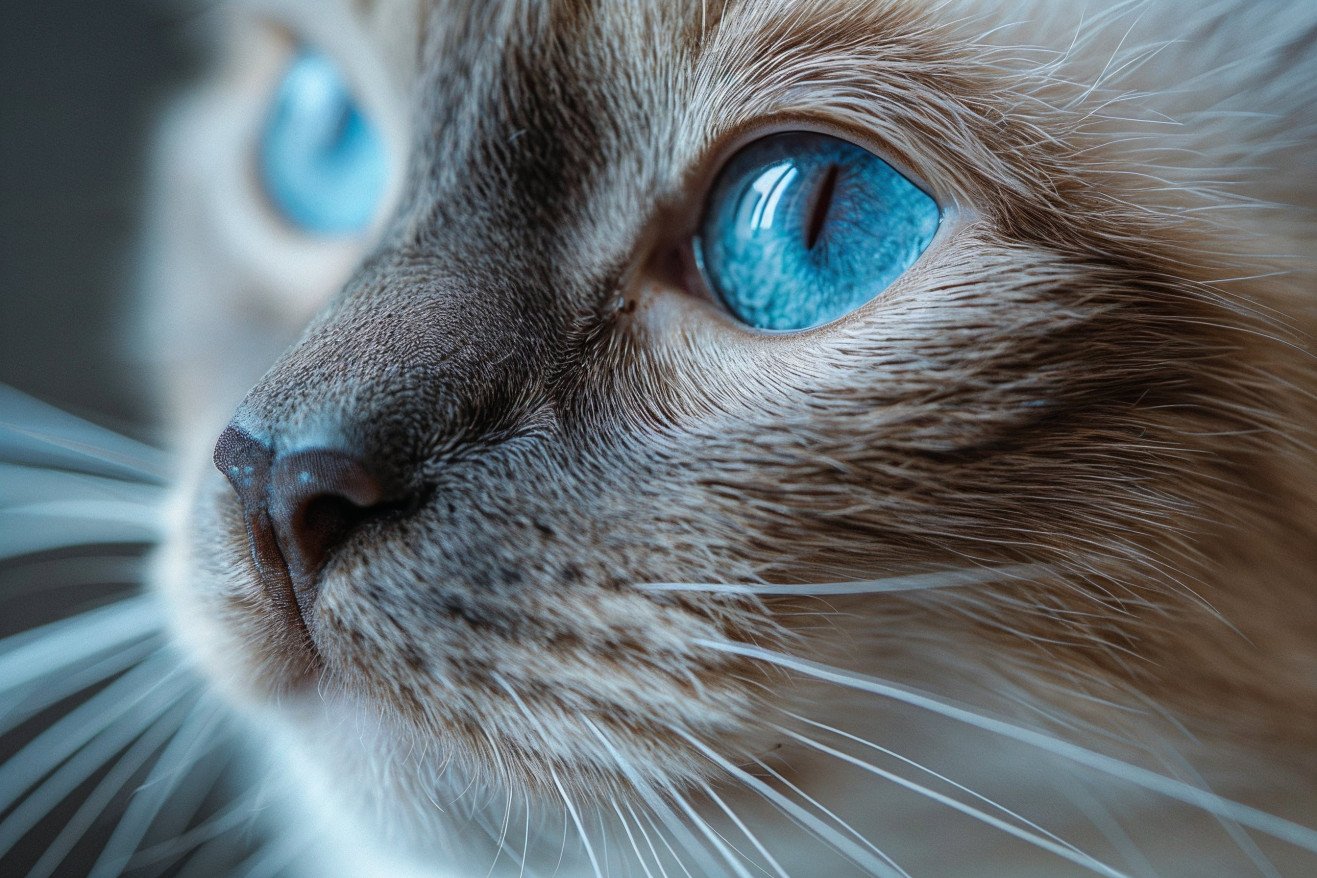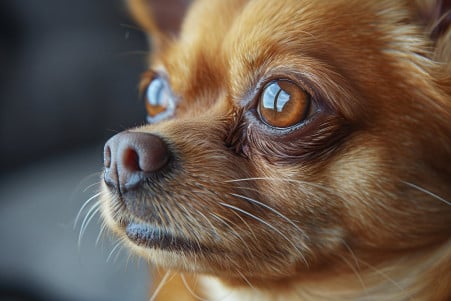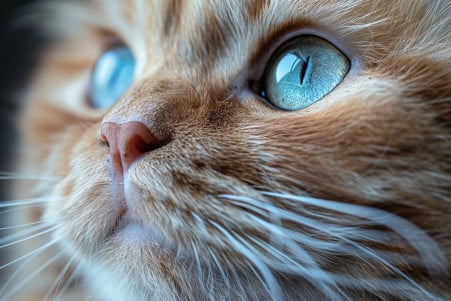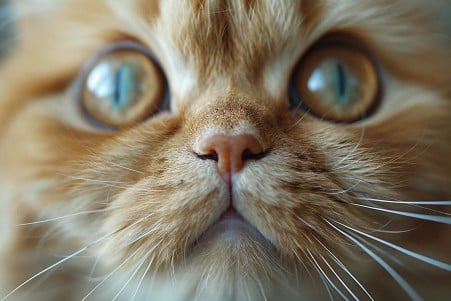Can Cat Whiskers Grow Back? The Science of Feline Whisker Regrowth
17 February 2024 • Updated 16 February 2024

Cat whiskers are more than just adorable facial accessories, but what happens if they are lost? Whiskers can grow back if they are lost or cut. However, the process can take several months, and while cats don’t feel any pain when their whiskers are cut, doing so can lead to disorientation and stress. For this reason, it’s best to let whiskers grow back on their own.
This article will draw on research from a range of scientific fields, including veterinary science, biology, and animal ethology, to explain the science of feline whisker regrowth. Through a review of the latest studies, this article will offer a thorough look at the biological mechanisms that make whisker regrowth possible and the importance of these sensory organs in a cat’s ability to navigate the world.
Find out how a cat’s whiskers change over time and what you can do to help keep them healthy.
Can cat whiskers grow back?
The Science of Whiskers
Cat whiskers, or vibrissae, are unlike regular hairs in that they are highly specialized tactile hairs made of keratin, the same protein that makes up human hair and nails. According to PetMD, each whisker is surrounded by a dense collection of nerves at its base, which provides the cat’s brain with detailed information about the cat’s surroundings.
In contrast to regular hair, whiskers have a unique growth pattern and are deeply rooted in the cat’s body, where they are connected to the muscular and nervous systems.
Whiskers are like regular hair in that they grow, rest, and eventually fall out. As Purely Pets Insurance explains, whiskers are thicker, stiffer, and more deeply rooted than regular hair, which makes them better suited to their role in sensory perception.
As a result, Biology Stack Exchange notes that it can take several weeks to months for a cat’s whiskers to fully grow back, and the exact time it takes can be influenced by the cat’s age and overall health.
When a cat’s whiskers are cut or damaged, it’s common for cat owners to worry. While the cat won’t experience any pain, it can lead to disorientation. However, if the hair follicle is left intact, the whiskers will grow back.
This is important because it shows how specialized these hairs are, which in turn underscores the importance of handling them with care. At the same time, it also demonstrates the cat’s incredible ability to regenerate.
How Whiskers Function as a Sense in Cats
According to Treehugger, cat whiskers, or vibrissae, are highly sensitive sensory organs that are directly linked to the nervous system. These long, stiff hairs have a proprioceptor at the base, which sends information about objects, air currents, and the cat’s position in space to the brain. This is important because, as VCA Animal Hospitals points out, it enables cats to move around their environment with precision, even when it’s dark.
As a result, the loss of whiskers can lead to a loss of spatial awareness in cats. Whiskers are sensitive enough to help cats determine how far away objects are and when the environment around them is changing.
This is important for protecting them from danger and helping them hunt. If they lose this ability, they may feel less confident in their ability to move around their environment, and they may have trouble with tasks like jumping and getting into small spaces.
According to Hills Pet, whisker regrowth is a natural part of the process and will help cats regain their sense of touch and spatial awareness. By understanding and respecting the role of whiskers in cats, we can help them maintain their impressive sensory abilities.
Things That Impact Whisker Regrowth
There are a number of things that can impact how quickly and effectively a cat’s whiskers grow back. One of the most important is a healthy diet, which is important for all hair growth, including vibrissae.
According to the Happy Cat Site, a cat’s general health can also impact how well their whiskers grow back. If a cat has a condition like mange or alopecia that impacts hair growth, it can also impact the regrowth of these sensory hairs.
Another thing that can impact how well a cat’s whiskers grow back is the breed of the cat. For example, the unique curly whiskers of the Devon and Selkirk Rex breeds don’t seem to impact their function, which suggests that genetics may play a role in the characteristics of a cat’s whiskers without impacting their sensory function.
In addition to genetics, age and the environment can also impact how well a cat’s whiskers grow back. Cats that are younger may have an easier time growing their whiskers back, while older cats may have a harder time.
Knowing these things can help cat owners make sure that their cats are in the best position to grow their whiskers back. A healthy diet and a low-stress environment can help ensure that a cat’s whiskers grow back as quickly as possible.
If you’re worried about your cat’s whiskers growing back, you should talk to your vet. With the right care, cats can make sure that their whiskers are healthy and able to help them sense the world around them.
Caring for the Whiskers: How to Keep Your Cat’s Whiskers Healthy
Because of their importance as spatial hairs, it’s important to care for your cat’s whiskers. According to Purina, cutting a cat’s whiskers can lead to disorientation and stress, so it’s important to let them shed naturally.
To avoid whisker stress, make sure that your cat’s living environment is whisker-friendly. This can mean using shallow, wide bowls for food and water, as deep bowls can cause the cat’s whiskers to brush against the sides and become uncomfortable.
Regular grooming can help you make sure that your cat’s whiskers are in good shape, but it’s important to be gentle when you’re working around these sensitive hairs. The whiskers around the eyes are also protective sensors, so be careful when you’re grooming around the face.
To avoid breaking the whiskers, make sure that your living environment is safe and whisker-friendly. For example, don’t use tight collars that could push against the whiskers or create narrow pathways in your home that could bend them.
By following these basic tips, you can make sure that your cat’s whiskers stay healthy and intact, allowing them to continue to use them to navigate and interact with their environment.
Whisker Wisdom: The Life Cycle of the Cat’s Regrowing Whiskers
In our deep dive into the world of cat whiskers, we’ve discovered that these special sensory organs are constantly growing back in a life cycle that’s important for a cat’s sense of space and overall health. Made of keratin and packed with proprioceptors, a cat’s vibrissae are more than just hair; they’re a vital part of how cats experience the world around them.
The regenerative powers of cat whiskers are truly amazing. Both Purely Pets and PetMD explain that cat whiskers grow back after being cut or damaged to continue to play their important role in a cat’s sensory system. While the exact time frame can be different for each cat, cat whiskers will grow back to their full length within weeks to months as long as the follicles are intact.
As pet parents, it’s our job to make sure we understand and value these natural sensors. We need to appreciate the importance of cat whiskers and make sure we’re taking them into account in our daily interactions with our cats. In this way, we can show that we respect not just our cats’ biology and instincts but also their natural drive to explore and live their best lives.


